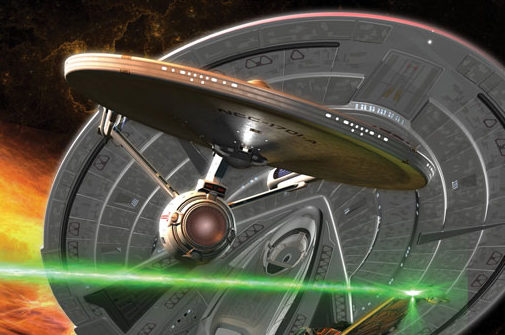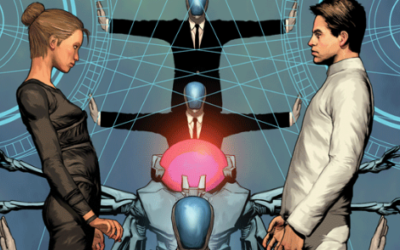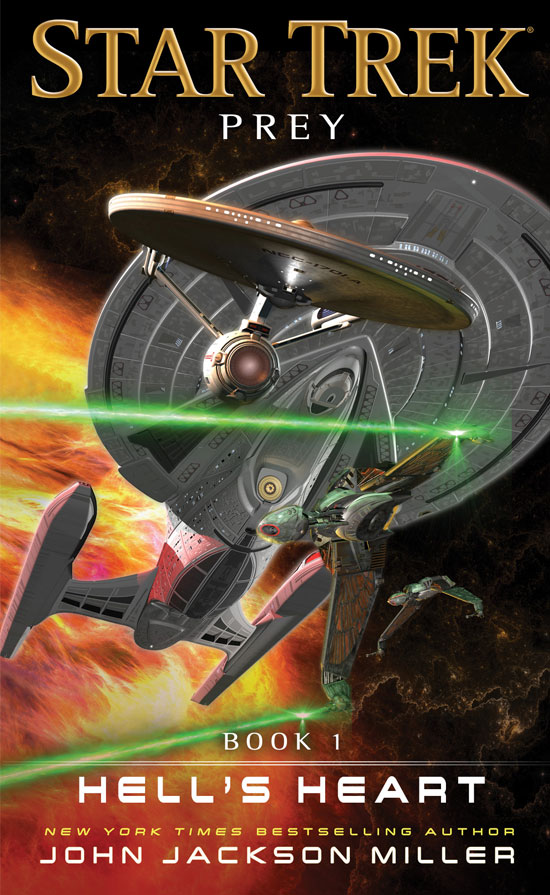 Wait – there’s science in there?
Wait – there’s science in there?
Yes – both Star Trek and Star Wars have science in them. Each universe has its own rules – inertial dampeners are a well-known (if made-up) technology of Star Trek, while the Force-focusing crystals of lightsabers are at home in a universe with Jedis and Sith Lords. Likewise, each universe puts its own emphasis on the science – or “science” of its universe. Too much science, and your Star Wars story is going to sound…off. Too little science, and Star Trek will start to feel less like the tech-heavy universe fans know, and more like say, Buck Rogers from the ‘30s.
Creatively, the balancing act between story and science can lead an author across some tricky ground, as John Jackson Miller can attest.
Miller’s writing career reads like a literary game of Frogger, with one job leading to another and then another. Miller, who started off editing and writing for The Comics Buyer’s Guide and Comics Retailer, landed a gig writing a Crimson Dynamo miniseries for Marvel, which lead to a run as the regular writer on Iron Man, which led to the comic adaptation of Indiana Jones and the Kingdom of the Crystal Skull, which led to Star Wars comics at Dark Horse, including the very popular 50-issue run on Star Wars: Knights of the Old Republic. His Star Wars comic work got him noticed by Del Rey, which got him writing Star Wars novels including Knight Errant, Kenobi, and A New Dawn, the first of the new canon Star Wars novels. Along the way, he’s also written Mass Effect comics, a Star Trek novella, a Halo short story and comics, and a Star Trek trilogy of novels (Star Trek: Prey) being released this September, October and November. He’s also one of the comic book industry’s most respected historians, especially when it comes to publication history and circulation numbers.
Whew.
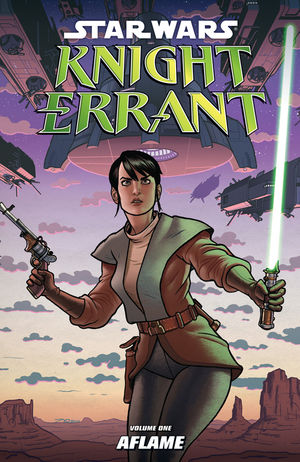 So yeah – back to science. Miller’s completely comfortable with the science needs of his respective universes, but that’s not to say that the needs are the same.
So yeah – back to science. Miller’s completely comfortable with the science needs of his respective universes, but that’s not to say that the needs are the same.
“In the case of Star Wars, I sneak the science in there,” Miller said. “It’s clear that we’re in a fantasy universe there were–it’s a space opera and they don’t want me figuring out why there’s no inertia for the space travel or why there’s constantly sound in space or anything like that.”
Given that any explanations wouldn’t serve the story, Miller said he wouldn’t be surprised to have any dissertations about the science edited out of the manuscript. As Miller sees it, science is never the point of a Star Wars story, which is why, for example, the fan response to midichlorians was largely negative. Aesthetically, it felt too “hard science” compared to Star Wars’ softer take on science.
But that’s not to say that there’s no science, or… “science” in Star Wars, and within the respective worlds, it needs to remain consistent. “With Star Wars, I’m dealing with things like: can you use the Force to read the mind of somebody who’s language you don’t know? What things can a lightsaber cut through and what things can it not cut through? Do lightsabers generate heat? All these sorts of things are questions that have answers. Those answers are relevant only to the particular franchise that you’re working on, but we do have to deal with them constantly.”
So what do you do when you’re faced with a question that would have a “science-y” and logical answer within the universe, but no one’s kept a comprehensive list of the “science” rules of the universe? Go back to the main sources, and see if you can find an answer. In the case of whether or not a Jedi can read the mind of someone whose language they don’t know – Miller went back to Return of the Jedi when Luke Skywalker influenced Bib Fortuna to lead him to Jabba the Hutt at Jabba’s palace. If you can plant a suggestion, Miller reasoned, then there must be some level of comprehension, so there must be some level of understanding, and therefore, yes, a Jedi can read the mind of an individual whose language they don’t speak or even remotely understand.
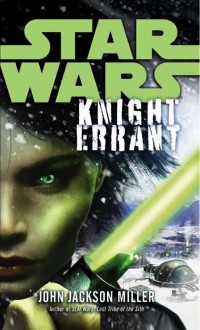 Likewise, for Star Trek, Miller recently had to search through sources to find out the rules for transporters, cloaking devices and shields, when all three are used together. In his upcoming trilogy, Miller went back to the original Star Trek movies – which, in case you’re wondering, showed crew members beaming aboard and off a Klingon ship while it was cloaked in Star Trek IV.
Likewise, for Star Trek, Miller recently had to search through sources to find out the rules for transporters, cloaking devices and shields, when all three are used together. In his upcoming trilogy, Miller went back to the original Star Trek movies – which, in case you’re wondering, showed crew members beaming aboard and off a Klingon ship while it was cloaked in Star Trek IV.
So while there may not be always be “hard” science in Miller’s takes on the worlds of Star Trek and Star Wars – what’s there has to be consistent with what’s been shown.
But…
“Now all of that said, I am fairly subversive when it comes to sneaking science in, so that at least I’ll respect myself in the morning,” Miller admitted. “I’m a hard science fiction fan. I grew up with Arthur C. Clarke, Hal Clement, and all the guys who were writing stuff where there was real science or new things based on real science.”
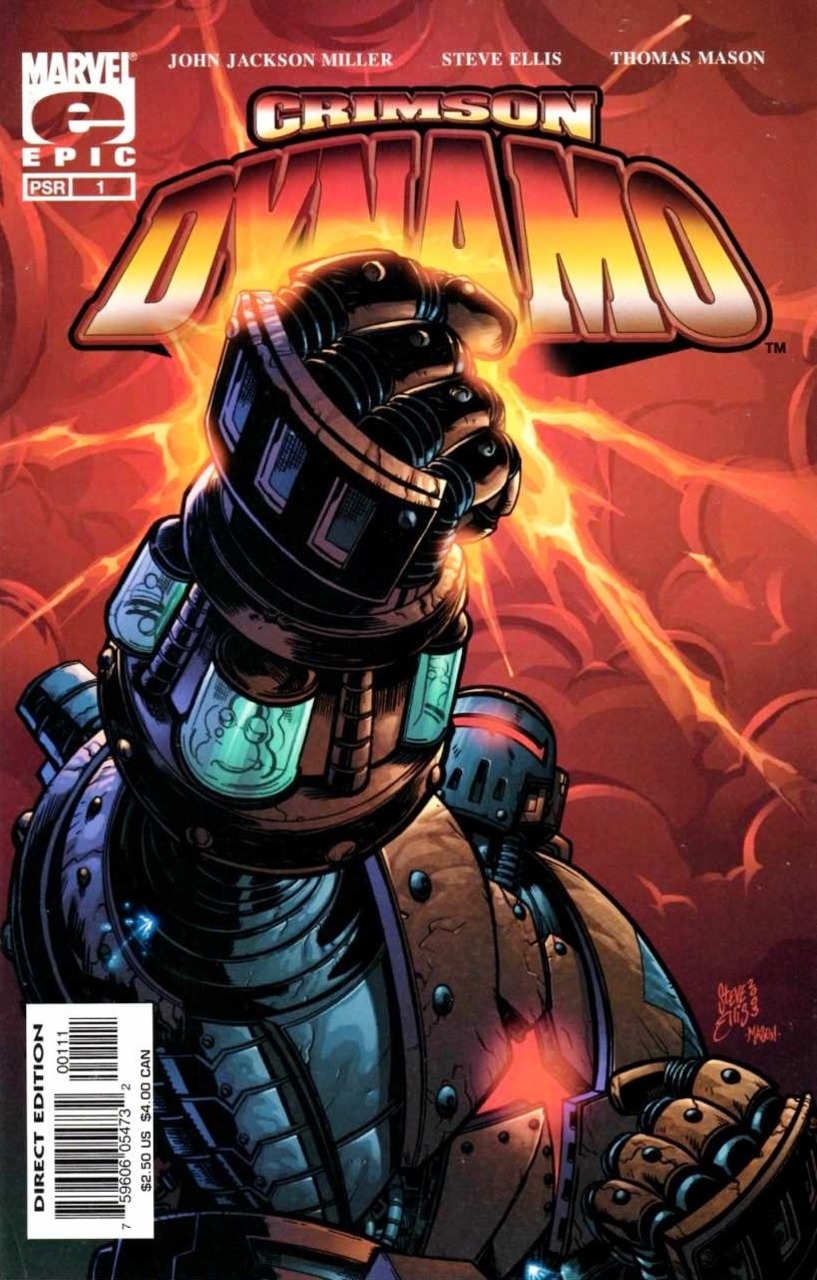 Miller’s love of the science in science fiction lead him to start college as an engineering student, with the intention of one day, designing spaceships. “I made it through about six weeks when I realized that honors calculus was not where I wanted to be,” Miller said. “And then of course, I was in Chemistry lab when I set the college’s record for the most glassware destroyed. So, it was clear that studying science wasn’t my cup of tea and I ended up going across the road to the journalism department. Although I did keep on taking the Russian classes, because I knew we would be working with the Russians in space one day and I wanted to know Russian.”
Miller’s love of the science in science fiction lead him to start college as an engineering student, with the intention of one day, designing spaceships. “I made it through about six weeks when I realized that honors calculus was not where I wanted to be,” Miller said. “And then of course, I was in Chemistry lab when I set the college’s record for the most glassware destroyed. So, it was clear that studying science wasn’t my cup of tea and I ended up going across the road to the journalism department. Although I did keep on taking the Russian classes, because I knew we would be working with the Russians in space one day and I wanted to know Russian.”
As an aside, Miller’s Russian studies did pay off years later, when he wrote Crimson Dynamo for Marvel, as part of the Epic imprint, which led him to his run as the regular writer on Iron Man which is remembered for, among other things, seeing Tony Stark serve as the United States’ Secretary of Defense.
“What I try to do is put stuff in that I will feel good enough about or at least that won’t make me go, ‘Eeu! that just would never happen.’ I’m notorious for in post-production of my comics having moons taken out of skies where they just couldn’t be. There are lot of artists and I don’t know what particular comic artist they originally got the idea from, but they’ll just draw lots of bunches and bunches of moons that are overlapping each other – a ridiculous number in the sky and I’m looking at the art thinking, that just doesn’t work. Or they get the crescents wrong, which is obvious. One of my earliest stories in Knights of the Old Republic was having a group of heroes in a spacecraft lifting off, going off into orbit above the day side of the planet and there’s a full sky of stars overhead. You cannot have a full sky of stars over the day side of a planet. You couldn’t see it. I’m always trying to figure out, if a place should or should not have gravity. I’m trying to acknowledge how explosive decompression really would work. I’m always trying to and sometimes it does actually get a little clunky having to account for these things but we’ve had too many years of superheroes just bopping about in space with no helmets.”
That time of characters “bopping around in space with no helmets” is long gone, Miller says. Audiences have changed – they’re both savvier when it comes to science, and, as Miller feels, there’s a hunger for having things explained.
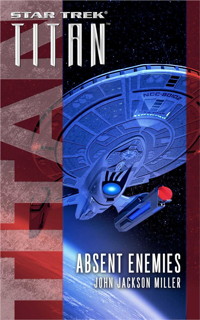 For example, in Miller’s first Star Trek book, Absent Enemies (part of the Star Trek: Titan series) the story was a sequel to the Next Generation episode, “Next Phase,” where Geordi La Forge and Ro Laren get knocked “out of phase” with the rest of the universe. The two realize they’re in another quantum state where matter can exist in the same space with other matter and occupy the same physical space at the same time. As a fan, the episode was fun to watch, Miller said – but writing a “sequel” presented challenges.
For example, in Miller’s first Star Trek book, Absent Enemies (part of the Star Trek: Titan series) the story was a sequel to the Next Generation episode, “Next Phase,” where Geordi La Forge and Ro Laren get knocked “out of phase” with the rest of the universe. The two realize they’re in another quantum state where matter can exist in the same space with other matter and occupy the same physical space at the same time. As a fan, the episode was fun to watch, Miller said – but writing a “sequel” presented challenges.
“So we have this episode where these two characters are running around the Enterprise and passing through walls like ghosts and they’re able to see everything. That happens. The problem with this episode is…well, it raises about 500 questions. Why don’t they fall through the floor? There’s also a scene where a Romulan sits down in a chair. The chair is in the real world, he’s in the phase world. How is he able to do that? Another thing, how are they actually able to see anything if the photons, in our universe, are passing through their eyes? How do they see anything? How can they breathe? What are they breathing?
“A number of fans had a multi-year discussion about this online. One of the other authors, Christopher Bennett, came up with his theories for it, and when I did my story, I used some of those and had some of my own as well.”
Miller’s theories about the “science” were all about that respect himself in the morning thing. “Science” rules that weren’t exactly “our” science, but given the evidence shown in the episode, remained consistent with the “science” of the Star Trek universe, as shown, but also needed a nod towards the Conservation of Matter.
“I basically said that the way that ‘phase matter’ interacts with real matter is that as soon as it enters the same area of any oxygen molecules that they would encounter, it suddenly enters this phase state by the fact that it’s in contact with the other matter and existing in the same space. Basically that’s how a quantum change happens to real world stuff, and the thing is, you would never tell or be able to tell that on a planet for example. If somebody was walking around phased and breathing the air the amount of air leaving the system…the real world system is so minuscule, you’d never notice it.”
There it is – open system vs. closed system.
“If Geordi and Ro had been on the Enterprise, for months and months though, someone would have notices that the ship was losing air – we notice that on our space ships and stations now. Also, they would have starved the death, which was the other problem they were going to have. But Absent Enemies ended up being a fun story because I actually wrote it about a faction that had phased themselves so that they could occupy the same holy land as their opponents. So they actually put into phase, camping gear and food and everything they would possibly need, so that they would exist in the same actual time and space.
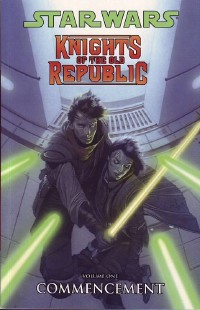 “As I saw it, it was fine to do an entire story based on studying the pseudo-science because that’s what that whole phased episode was anyway. In Star Trek, it’s okay to actually make the science, part of the plot. In Star Wars, you can’t make science part of the plot. The extent to which science becomes part of a plot is, the Death Star must be cleared to fire. The Death Star must go around the gas giant to be able to fire.
“As I saw it, it was fine to do an entire story based on studying the pseudo-science because that’s what that whole phased episode was anyway. In Star Trek, it’s okay to actually make the science, part of the plot. In Star Wars, you can’t make science part of the plot. The extent to which science becomes part of a plot is, the Death Star must be cleared to fire. The Death Star must go around the gas giant to be able to fire.
But that’s not to say that Miller doesn’t put the same attention to science…or “science” detail into his Star Wars work. “In A New Dawn – the novel that I did, the first novel in the new Star Wars canon, I wanted an earth-shattering kind of a weapon but I didn’t want another gun. I didn’t want another MacGuffin device. And so, because mining in space was the point of the story, I had this villain who was planning on destroying a moon, shattering it and basically picking out the stuff that they wanted out of the remains. And what I did, was I actually–and this was in cooperation with a friend of mine back in high school that knows science a lot better than I do–worked out the orbital mechanics of the system. Because in fact, if you were to destroy our own Moon in place and do it right, in a controlled fashion, nothing really would happen to the earth…well, for a little while.
“I had to actually set up the orbital mechanics of the system, so that the orbit was highly elliptical, and helped to preserve the material in the moon explosion. I also made the planets close to a double planet system, and the moon was smaller but it was denser. So, we had masses that are on a similar order but not exactly the same. So shattering one of them since they’re both really orbiting a similar point…I calculated the Lagrange points and figured out where the Roche Limit was.”
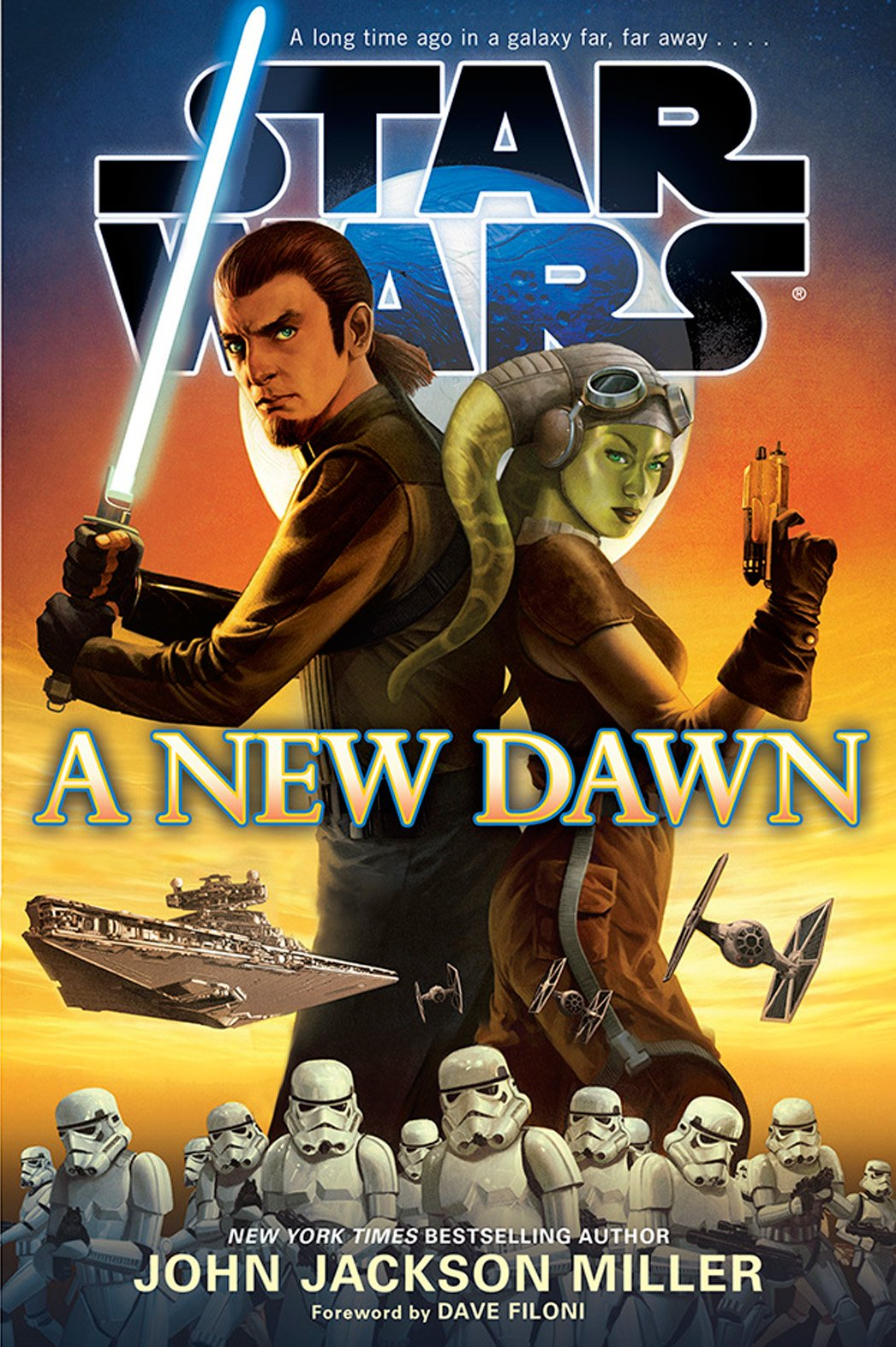 Okay – so this sounds like Miller’s going back on his earlier claim about Star Wars not being about the science, right? You’d be right in thinking so, but Miller made sure not to put all his orbital mechanics research into A New Dawn as straight-up exposition.
Okay – so this sounds like Miller’s going back on his earlier claim about Star Wars not being about the science, right? You’d be right in thinking so, but Miller made sure not to put all his orbital mechanics research into A New Dawn as straight-up exposition.
“I put it in the mouth of an Imperial officer whose character was designed for the purpose of spouting the stuff and acting like, ‘This is so cool, it’s worth trying, let’s see what happens,’” Miller said. “So, it was something where I put it in there to head off anybody saying, ‘What a stupid idea, this wasn’t thought through.’ Putting it in the mouth of the office was there a self-defense for me and also I got this funny scene where we have this character who shows up and does the, ‘You guys look! This is this, this does this and this and this, and wow! No one’s ever done this before!’
“It was different than everything that we had done in the past, but I put that little discussion there. We’re not doing the full Tom Clancy – here’s a long dispensation on orbital mechanics and how this works. I made it a character moment, and here’s the other thing: since it was in somebody’s mouth, if I was wrong about any part of it, I can blame the character. If something – some detail isn’t right, you know, maybe the character was misinformed. It’s when the narrator opens his big mouth – then somebody can call you out on your bad science.”
Although, as said, Miller does as much as he can to prevent bad science from cropping up in his work, and he’s as transparent as he can be about his process.
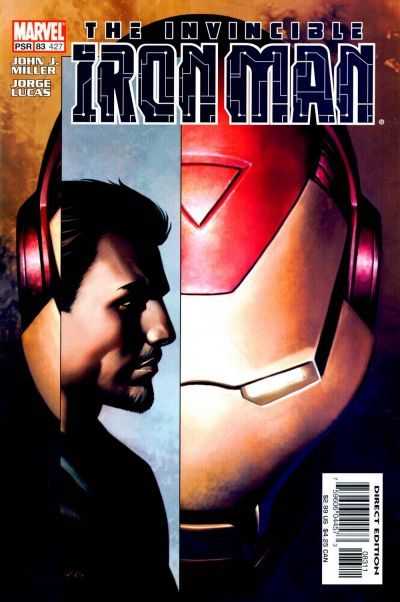 “When things aren’t done correctly, speaking as a fan, that laziness on the part of the creator just drives me up a wall. I figure I’ve got at least a few people like me out there, and I want them to feel like I did the work,” Miller said. “That’s one reason why when I started doing comics professionally, I started a website farawaypress.com where I have behind-the-scenes pages on everything I’ve ever done. So you can go in and see, for example, in Iron Man #83 where he’s flying in a highly accelerating space ship trying to intercept a comet. The space ship is named the Clement, by the way, for Hal Clement who wrote Mission of Gravity. The ship is accelerating at 50gs, and I did the math for the time dilation to see how much time would dilate, because one of the plot elements is that the time is compressed, and Tony knows this stuff. He obviously would and I had to figure out exactly how much time would compress if he had gone for 48 hours accelerating at 50gs. And then simultaneously, I had to invent high gravity armor for him.
“When things aren’t done correctly, speaking as a fan, that laziness on the part of the creator just drives me up a wall. I figure I’ve got at least a few people like me out there, and I want them to feel like I did the work,” Miller said. “That’s one reason why when I started doing comics professionally, I started a website farawaypress.com where I have behind-the-scenes pages on everything I’ve ever done. So you can go in and see, for example, in Iron Man #83 where he’s flying in a highly accelerating space ship trying to intercept a comet. The space ship is named the Clement, by the way, for Hal Clement who wrote Mission of Gravity. The ship is accelerating at 50gs, and I did the math for the time dilation to see how much time would dilate, because one of the plot elements is that the time is compressed, and Tony knows this stuff. He obviously would and I had to figure out exactly how much time would compress if he had gone for 48 hours accelerating at 50gs. And then simultaneously, I had to invent high gravity armor for him.
“Actually, what was fun about it, is that book opens with him feeling drunk and wanting to throw up, in the armor. He’s like, ‘Oh my God, I’m drunk again,’ And then he realizes, ‘Oh no, I’m not actually drunk. I’ve got…’ I think it was the bends, but I’d have to check how I had him explain it. I made a plot element out of it. I put it out front in order to get a moment from it.
“I just don’t want to come off as lazy about this stuff. Yeah, the people that know this stuff are maybe about 1% of the audience that are reading, and they’re satisfied too. And, because I want to get credit for having done this research, I put it on my website.”
Miller’s done a little bit of rule-bending, though. For example, in his own novel, Overdraft, a plot element was the I Love Lucy television signal traveled through space and…long story short, started an interstellar war. Under normal circumstances though, and even though we love to talk about how “far” our television and radio signals have traveled through space…Lucy wouldn’t have gotten out of the solar system, let alone into interstellar space.
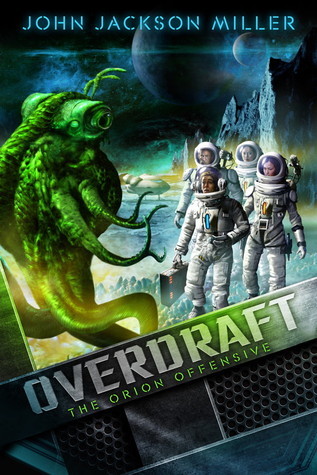 “Television is designed to be transmitted through the atmosphere to places that are on the ground,” Miller said. “So VHF and UHF waves, which aren’t that energetic to begin with, weren’t pointed into space to begin with, and they’re not that high energy. Satellite transmissions are pointed down too. I had to create a character in the 21st century who was an eccentric billionaire who was using lasers to transmit the signal upward and outward to people.
“Television is designed to be transmitted through the atmosphere to places that are on the ground,” Miller said. “So VHF and UHF waves, which aren’t that energetic to begin with, weren’t pointed into space to begin with, and they’re not that high energy. Satellite transmissions are pointed down too. I had to create a character in the 21st century who was an eccentric billionaire who was using lasers to transmit the signal upward and outward to people.
In closing, when it comes to science fiction’s role in society, Miller agrees with the widely held premise that it allows us to have a collective “dream” of the future, in the way for instance, where we all are carrying around communicators and PADDs from Star Trek’s universe today. But given his political background and world view, Miller also said there’s more that science fiction allows us to do.
“Science fiction’s role is being able to allow us to talk politics and philosophy at a distance,” Miller said. “When you have a polarized society and people get bent out of shape about anything that they feel has a cultural bias or anything like that or a political bias or anything like that, science fiction – and this obviously goes all the way back to Star Trek and before – is able to tell allegorical stories about all sorts of things. And it doesn’t feel like you’re being preached at.
“Science fiction and fantasy have that role in terms of allowing us to come at our society at a bit of an angle that allows us to fly under the clouds of craziness that are out there. Not as far as science fiction’s role in creating – we’re imagining things that are going to be in the future down the road. I think what I really like is the fact that we got The Martian, which a procedural that was the science fiction equivalent of Apollo 13. If you watched Apollo 13, you’ll learn dozens of things about space travel, about chemistry, about biology. What they did with The Martian, it was just very simple. It was the same story as Apollo 13 – just it set in a different location and it was one guy coming up with everything. And he had a foul mouth and so he was entertaining. But I mean, you could actually feel good about watching that and say to yourself, ‘I learned something. I learned a few things.’
“I guess I view it on a continuum which is the harder the science fiction…the more important the science is to the story, the more your responsibility is to get it right because there’s an educational facet to it, the more it’s space or the future or whatever, it’s just an allegorical location, a way to tell stories about people and things.
“One of the most interesting things for me is looking at science fiction over time and what the balance has been between how often the most popular stories are completely escapist and not using anything from reality at all. For example, the science fiction in the ‘70s had a mood to it that was dystopic. It was a reaction to the ‘60s and the loss of hope and the loss of the feeling of promise that had been forwarded, the ‘70s gave us Soylent Green, Logan’s Run, Silent Running – these dark and depressing and sad stories. It’s not until Star Wars comes along that there’s a turnaround and we headed back into escapist fantasy for a while. If you look across time, there’s probably some sort of pattern to be perceived about when the science in science fiction is more real and what knock-on effects that has down the road.”
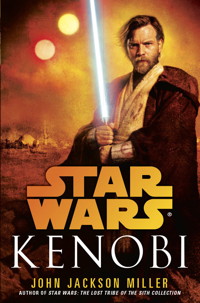 One of Miller’s pet projects – a non-franchise, creator-owned work will be set in the near future, which puts him in the place of predictor of things to come, based on today’s reality, which seems to be a large component of the science fiction of the past couple of decades.
One of Miller’s pet projects – a non-franchise, creator-owned work will be set in the near future, which puts him in the place of predictor of things to come, based on today’s reality, which seems to be a large component of the science fiction of the past couple of decades.
“Look at Minority Report,” Miller said. “That gave us basically, how the graphical user interface would go into the future. Pinching and moving screens and everything like that, that he does in that opening sequence, all of that came through. Even though we look at that as being foreshadowing of our own world, that’s a lot more challenging. Guessing what things are going to be like in ten years is far more challenging than a thousand, because in a thousand, your standard deviation on accuracy is going to be way too high, and it’s totally okay if you got everything wrong at that point. But, the closer you get to the present…the trickier that prediction gets.
“On this thing I’m working on, I’ve got a calendar for 2021 set on my computer. I don’t want to say Christmas is on the wrong day. But again, I’m weird like that. And I work under the assumption that there’s a number of readers that are also weird like that. And I think it’s turned out to be reasonably accurate, or at least I do hear from people who are appreciative of the time that I put in. This is the game I play.”


